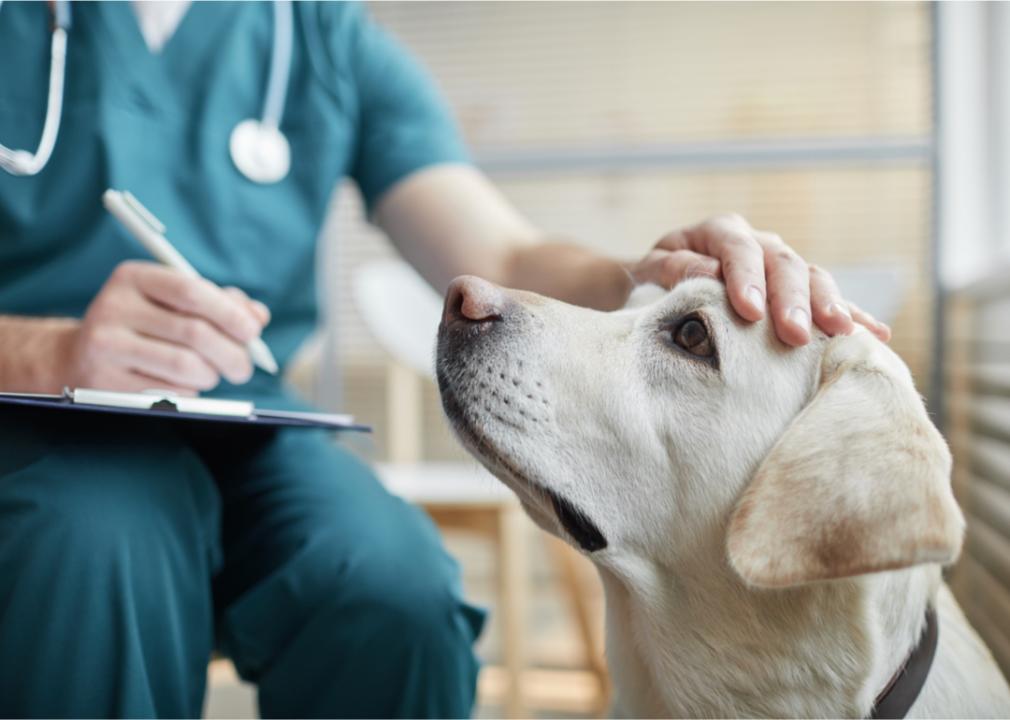Common health problems for popular dog breeds
Published 12:15 am Saturday, May 7, 2022
SeventyFour // Shutterstock
Common health problems for popular dog breeds
If you’re asked to name a few loyal friends, chances are your dog’s name would be top of mind. They’re the friends waiting patiently by the door when you return home, showing every ounce of gratitude for a full dinner bowl. Their loyalty and companionship have earned them a spot as “family” for many pet owners.
It can be difficult for pet owners to watch their dog experience pain and to feel helpless to do anything about it. To avoid that feeling, it’s important to watch for red flags that indicate a trip to the vet or some extra care is needed to keep your dog happy and healthy.
The focus of this piece is to identify common symptoms and diseases that could turn your tail-wagging, happy dog into a listless couch potato. Having the right information can help identify symptoms and put you on track to seek necessary care for your dog early on. For instance, noticing low-hanging ears can clue you in that your dog isn’t just tired, but may have ear infections.
ManyPets analyzed common health problems among the American Kennel Club’s most popular dog breeds for 2021. Some of these problems range from seemingly minor issues like a cough to more serious issues like degenerative myelopathy, which is a spinal cord condition. There are general symptoms of these conditions common to most breeds, though some breeds have unique symptoms beyond this list. Have a look at some common health conditions that could affect your four-legged family members.
![]()

SasaStock // Shutterstock
Hip dysplasia
A little anatomy lesson is needed to understand hip dysplasia. The hip is a ball-and-socket joint, and as dogs grow, they naturally grow at the same rate. For dogs with hip dysplasia, there’s an irregularity in the rate of growth, which causes the ball and socket to improperly fit.
If your furry friend begins to show decreased activity and range of motion; loss of thigh muscle; pain, limping, or stiffness; struggle with or reluctance getting up, jumping, or climbing stairs; and lameness in the hind limb—or there is a visible increase in the shoulder muscle as they compensate for the hind limb—the culprit might be hip dysplasia.
Any breed of dog can develop hip dysplasia, but it’s commonly found in Labrador retrievers, golden retrievers, German shepherds, poodles, beagles, Rottweilers, German shorthaired pointers, and Pembroke Welsh corgis.

Mary Swift // Shutterstock
Eye conditions
Have you noticed your dog squinting or tearing up more than usual? It might be a symptom of eye infection. Its causes include viruses like canine influenza, bacteria, fungus, irritants, parasites, and eye injuries. These are causes of common eye conditions such as conjunctivitis, uveitis, inflammation of the cornea, and complications in the eyelids and tear glands.
Some symptoms that show a dog might have an eye infection are: squinting, pawing the eyes, swelling, cloudiness, redness, loss of vision, or excessive tearing/discharge. Eye conditions can affect any dog at different phases of its life. But breeds like Labrador retrievers, French bulldogs, golden retrievers, poodles, beagles, Rottweilers, German shorthaired pointers, and Pembroke Welsh corgis are more likely to develop eye conditions.

Olena Brodetska // Shutterstock
Elbow dysplasia
Elbow dysplasia, like hip dysplasia, is a joint condition caused by the abnormal growth of the front legs. This condition causes dogs to limp a little, favoring one or both of its front limbs. The signs of elbow dysplasia are often intermittent and hardly visible, making it difficult to diagnose.
To get ahead of it, screening often is essential for early diagnosis. Some signs to watch out for are stiff elbow joints, cracking sounds when the elbow joints move, and irregular rotation of the joint. Elbow dysplasia is especially common in medium-to-large dogs and breeds like Labrador retrievers, golden retrievers, German shepherds, German shorthaired pointers, and Pembroke Welsh corgis.

EvaHeaven2018 // Shutterstock
Heart disease
The heart is a vital organ that needs no introduction. In dogs, mitral valve disease, dilated cardiomyopathy (a disease of the heart muscle), and arrhythmias are common diseases that affect the heart. Some breeds like Labrador retrievers, Golden retrievers, Rottweilers, German shorthaired pointers, and Pembroke Welsh corgis are more susceptible to these diseases.
However, no matter the breed, if a dog shows symptoms like coughing, fainting, breathlessness, low energy, heart murmurs, weight loss, and abdominal swelling, it might be a heart problem. But don’t panic—dog owners can effectively manage many kinds of heart disease with medicine, regular monitoring, and lifestyle changes.

Natalia Fedosova // Shutterstock
Ear conditions
Cleaning dogs’ ears is part of their regular care. However, due to environmental and hereditary factors, a dog might pick up an ear infection here or there. These factors include allergies, wax buildup in the ear, and autoimmune disorders. Over-cleaning can also cause irritation and infection.
When dogs scratch or shake their heads intensely, it is often a sign that the dog needs an ear cleaning. Odor, redness, or swelling in the ear and dark discharge are signs of ear infections. Breeds with low-hanging ears like golden retrievers, beagles, and dachshunds are susceptible to ear infections. But other breeds like the Pembroke Welsh corgi can also develop ear infections.

otsphoto // Shutterstock
Spinal conditions
Conditions that affect the spinal cord can be a concern to pet owners. These can affect vital functions of the dog’s body movement, sensation, urination, and defecation. Some common symptoms of spinal cord diseases in dogs are pain, lameness, loss of balance or coordination, and changes in gait. Partial or total paralysis and urinary or fecal incontinence are also symptoms of spinal cord diseases.
Breeds like German shepherds, dachshunds, and Pembroke Welsh corgis have a higher risk of being affected by spinal conditions. Common examples of these conditions are back pain, degenerative myelopathy, syringomyelia and hydromyelia (in which excess fluid accumulates in the spine), and benign or malignant tumor growth.

everydoghasastory // Shutterstock
Respiratory conditions
Dogs can experience a range of breathing problems and respiratory illnesses, so it’s important for dog owners to know the symptoms. Some common respiratory conditions that affect dogs include pneumonia, kennel cough, tracheal collapse, chronic bronchitis, and rhinitis.
Depending on the condition, the symptoms are different; however, there are general symptoms dog owners should watch for. These symptoms include coughing, poor appetite, wheezing, gagging after coughing, nasal congestion, reduced exercise tolerance, difficulty breathing, and fainting. Any dog can contract a respiratory illness as they explore the world with their nose, but French bulldogs and American bulldogs are more susceptible to these conditions.

DreamBig // Shutterstock
Skin conditions
Dry, itchy, or flaky skin is just as uncomfortable for dogs as for humans. Often, dry skin is an indication of an underlying problem. These problems could range from minor allergies to severe disorders like hypothyroidism and Cushing’s disease. Some symptoms associated with dry skin are dandruff, flaking, pimples, inflammation, odor, scabs, increased oiliness, itchiness, hair loss, and scaling. Some dogs only show one of these signs, while others show many.
These conditions are commonly found in French bulldogs and can be avoided by taking preventive measures that ensure your pet’s skin remains healthy. Using a humidifier, applying dog-approved moisturizers, and making sure your dog has a skin-healthy diet are all advisable.

topdigipro // Shutterstock
Joint inflammation
Joint inflammation are two words that large-breed dog owners dread hearing. Osteoarthritis is a joint disease that results in joint inflammation caused by the wear and tear of the cartilage. Osteoarthritis can be difficult to detect in its early stage. Still, certain symptoms can be warning signals of osteoarthritis, including reluctance to run or play, weight gain, stiffness, lameness, and lethargy. Irritability, behavioral changes, and reduction in muscle mass around the limbs and spine are also symptoms.
Osteoarthritis is widespread in poodles and dogs with other risk factors. Regular checkups are essential to catch signs of osteoarthritis before the problem compounds.

Maria Sbytova // Shutterstock
Epilepsy
Epilepsy is a seizure disorder caused by abnormal electrical activity in the brain. Seizures can also be triggered by trauma to the brain, cancer, kidney and liver disease, low or high blood sugar, electrolyte abnormalities, severe anemia, and exposure to toxins. In some cases, seizures are easy to spot, like when a dog flops to the floor and is visibly convulsing. In other cases, it may be localized, like unusual barking or facial tremors.
However, regardless of the type of seizure, dogs usually recover quickly. Some symptoms that point to seizures are foaming at the mouth, drooling, jerks, shaking or muscle twitching, fainting, and collapsing. Epilepsy is common in beagles, but other breeds can also experience this seizure disorder.
This story originally appeared on ManyPets
and was produced and distributed in partnership with Stacker Studio.






